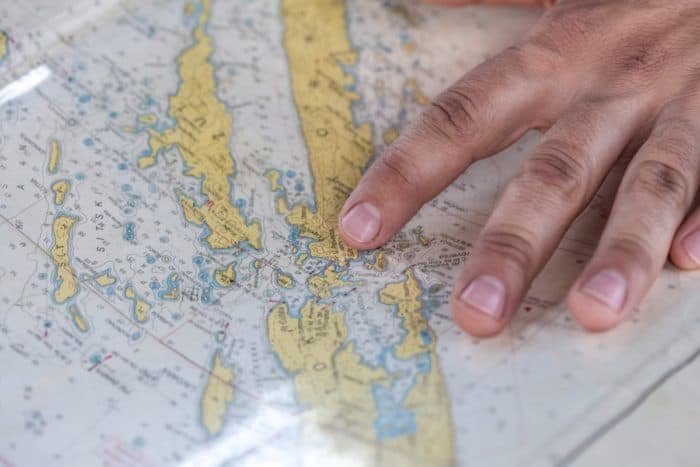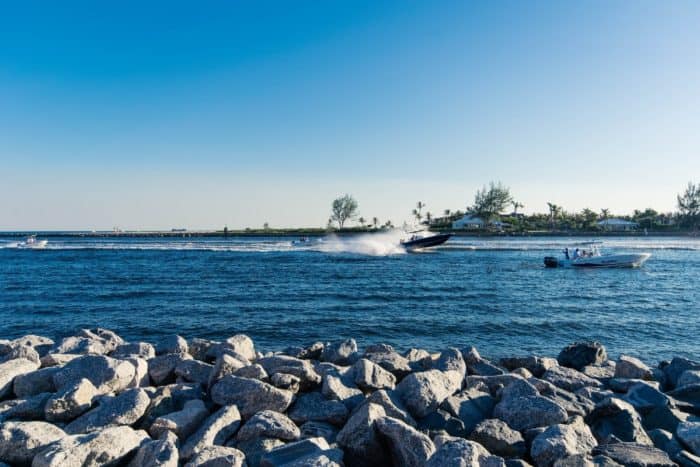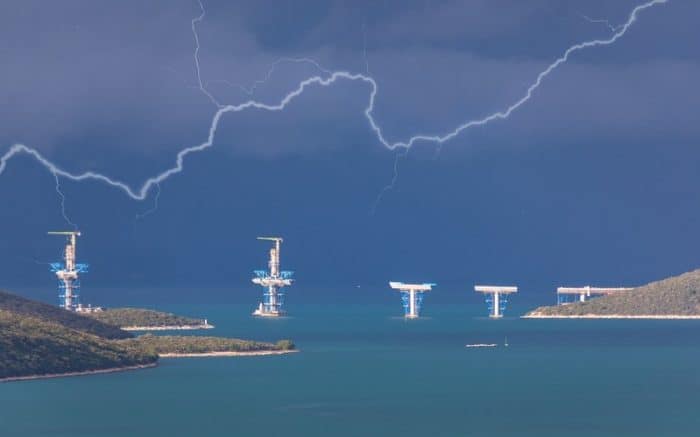Navigating Inlets: A Practical Guide For Any Boater
Navigating inlets cannot be mastered by reading a single article. All inlets are different, and circumstances such as weather, your vessel and the presence of other boaters can alter how you navigate. Therefore you’ll need to understand the best practices for navigating any particular inlet and combine those with common sense at the moment.
What is an Inlet?

Inlets are typically long, narrow openings that lead from one body of water to another. Maybe the inlet leads from the open ocean or a lake into a bay or a lagoon. Because they are a junction between bodies of water, the current in an inlet can change dramatically as water is exchanged in and out with the tides.
What Makes Navigating Inlets Difficult?
Like anywhere in the water, an inlet can be calm and easy to navigate at one moment and then dangerous the next thanks to something like a strong onshore wind. Many circumstances can take ocean inlets from a simple, easy-navigated waterway to something troublesome. You’ll need to be aware of:
- Water levels and tides which can expose dangerous obstacles
- Severe weather
- The presence of other boaters
Even though an inlet may be a short journey in fair conditions, it can be very dangerous in poor conditions. Strong winds and currents can make what would otherwise take minutes become deadly. It is not unreasonable to avoid an inlet altogether in poor conditions and wait hours, even overnight, for conditions to improve before trying to pass. This is always the better option than putting yourself or others at risk.
In the worst circumstances, with an ebbing tide and high winds, waves can reach dangerous heights of four to six feet or more and arrive frequently. For many smaller vessels, this is life-threatening. Navigating an inlet requires understanding the timing of the tides and these currents.
Preparing to Navigate an Inlet

Your most valuable tool when it comes to navigating an inlet is your eyes. As you approach, look at what you’re getting yourself into.
- It never hurts to learn an inlet from the shore before you navigate. Most boaters will never do this but research is never a bad idea. Use binoculars and just check the lay of the land (or sea, as is the case) to get an idea of what’s in store.
- If you’re new in the area, feel free to ask fellow boaters what to expect. Your local marina should have some helpful info, or ask around with some commercial boaters or others who have extensive experience in the area who are likely to have navigated the inlet many times.
- Once on the water, if you can already see the waves are precarious and things look treacherous, turning around early is probably your best bet.
- Make sure you know your vessel. You understand what it can handle better than anyone. If you are unsure because the boat is new or you have never tried to navigate more treacherous waters, this is not the time to test it. Back off and wait for smoother sailing conditions.
- Do not approach an inlet if you can already see the waves are more than your vessel can handle. If you get too close “just to make sure” and something unexpected happens like your engine dies or your electrics fail, you could be rendered helpless.
- Alongside what you can see, trust the science. Any time you head out you want to check the marine weather forecast ahead of time. Check your local charts and information for local mariners regarding the inlets you’ll be navigating.
- Make sure you know the tides and currents in the inlet and whether they are going to affect your attempted navigation.
- If you cannot safely navigate the inlet, don’t. Even if you were offshore and are trying to come back inshore. It may be inconvenient but you should find a place to safely moor the vessel and wait.
- Make sure your gear is all safely stowed. If conditions get rough, you don’t need the distraction of things moving around on the boat.
- In a worst case scenario, such as trying to come inland at night or in conditions that otherwise render you unable to judge the situation, ask for help. The local marina, other boaters or the Coast Guard are a radio call away and can better advise you for your specific conditions and best course.
Equipment You Need to Navigate an Inlet

Assuming you are ready to navigate the inlet, you’ll want to have various tools and equipment at the ready to help you out. These aids to navigation can be invaluable in this situation.
- GPS and charts are helpful tools when handling inlets. Some inlets, especially narrow ones, could have fast moving currents you’ll need to deal with. You may have to deal with standing waves caused by storms far away causing swells in the inlet. There may be no wind at all but the storm swells cause the shallow inlet water to rise up. This could threaten to capsize your boat.
- Your charts and knowledge of local inlets will help inform you about shifting shoals and submerged rocks or other hazards.
- Safety equipment needs to be at the ready and this should go without saying. Make sure you have a functional VHF radio and everyone on board has a personal floatation device, just in case.
- Monitor channels 13 and 16 on your radio. Channel 13 is ship-to-ship communication and if there are commercial vessels in the inlet you’ll want to monitor this. Keep in mind this is a low power transmission of just a single watt, so it only works when vessels are close together.
Navigating the Inlet

- Aids to navigation (ATONs) are vital for navigating an inlet safely. These include buoys and other markers that lay out which waters are safe and which are not. You need to keep a keen eye, especially if conditions are not ideal, to make sure you don’t miss any. Missing a shallow water marker during rough seas could cause you to run aground, for instance.
- Start at the sea buoy if you are entering the inlet from the open water. This is the start of the channel buoys and if you start here you can help map your path through the other buoys along the way.
- Use the wind. If you’re waiting for your time to navigate the inlet and conditions are not totally ideal, try to wait for the wind to be heading in the same direction as the current. This will help to flatten out some of the waves and make your journey a little easier.
- In addition to markers, keep a watch for other boaters. You can only be responsible for your own behavior on the water and react to others if and when they disobey the rules of the road and put you in danger. In inlets, it’s not unheard of for some reckless boaters to travel too quickly, cross lanes, and so on. Always use caution when navigating an inlet around other boaters and never rely on someone else to do what you think they should do. You never know the circumstances on another vessel.
- Try to make sure your first run of the inlet is under ideal conditions. Get to know it when the weather is on your side and later, if things get rough, you’ll have a sense of familiarity for where you want to be. This is especially important if your boat is new and you are not 100% sure how it handles in all conditions. You’ll want to know your vessel’s strengths and weaknesses for navigation. Speed, maneuverability and handling of your specific vessel will all come into play.
What To Do When In a Raging Inlet/Very Dangerous Conditions

If you find yourself in a narrow channel that is turning out to be too precarious for you, there are some steps you can take to safely get through.
- Use a spotter. If possible, have someone bow and stern to help spot aids to navigation, other boaters, waves, or hidden dangers. Keep clear communication open and adjust your course as the inlet conditions dictate.
- Master the waves. If the waves are playing havoc with you, adjust your approach. If you can safely do so, outrun waves at your stern or pace just ahead of them breaking. You can throttle back and ride waves in if necessary, letting the wave move under the boat. Just don’t top the crest of a wave or put yourself at risk of dropping the bow too deep.
- Keep aware: If you see another boater coming at you in a dangerous manner, don’t cut and run. You don’t want to put yourself at risk unless it’s the only way to avoid a direct collision. You can use channel 16 on your radio to signal the other boat and use your horn to sound a danger signal.
The Bottom Line
Navigating an inlet in poor conditions can challenge even a seasoned boater. Unpredictable swells, waves that can grow many times larger than those on the open water, and hidden dangers abound.
Know your vessel before you try to navigate any inlet but especially an inlet when conditions are less than ideal. Understand how it maneuvers and what its limitations are. Know how you need to handle breaking waves and if you have enough power to maneuver dangerous conditions.
Be prepared by studying the charts, the tides, the currents and the weather on the day. You can limit surprises by navigating a dangerous inlet in calm waters ahead of time and by asking more practiced captains about the inlet to learn from their experiences. They can tell you if a powerful outgoing tide streaming along through that channel and a strong onshore wind tend to make things too harsh for navigation.
Follow your navigational aids, keep communication lines open and be aware of everything happening around you, even if that means having a spotter or two on deck to help you out.
In the worst case scenario, don’t navigate rough inlets at all. If conditions are too dangerous, find a place to safely moor and wait for calmer seas.
Categories: nauticalknowhow











